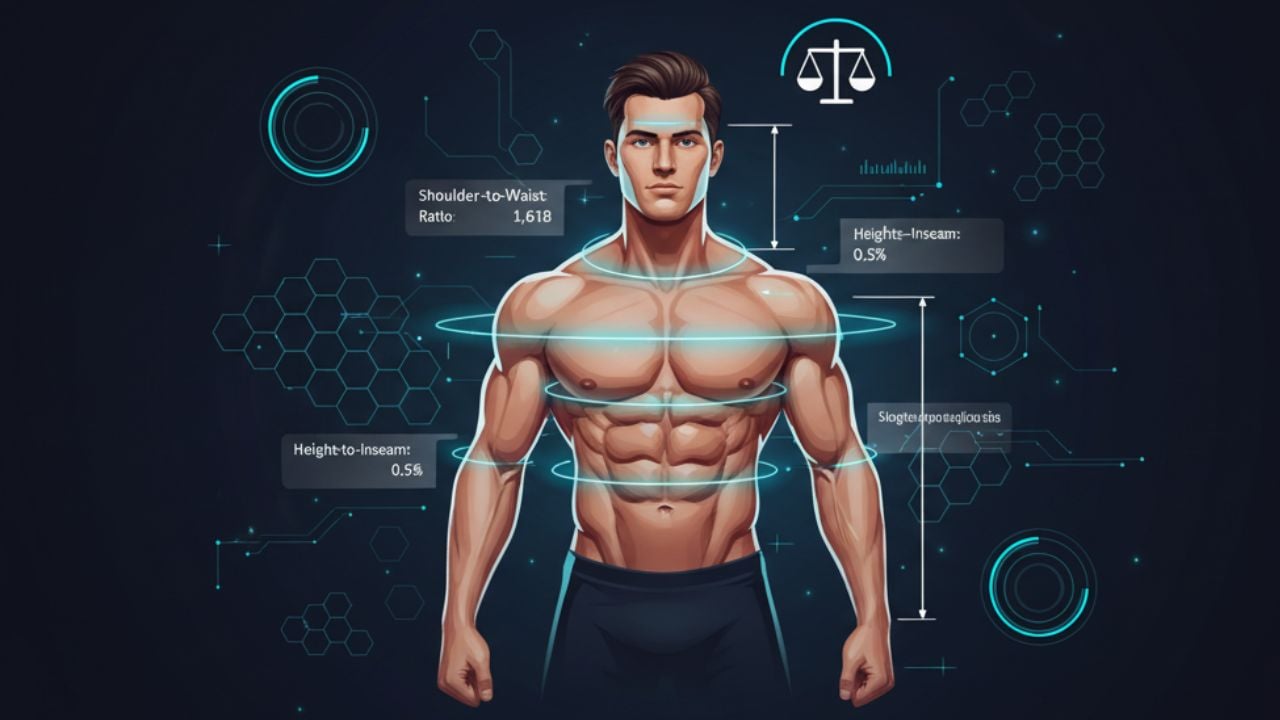Ideal Body Proportions Calculator
Calculate your ideal body measurements using Steve Reeves’ classic proportions system – based on your wrist size and bone structure

What Are Ideal Body Proportions?
Ideal body proportions refer to the balanced relationship between different muscle groups that create a symmetrical, aesthetic physique. Steve Reeves, the legendary bodybuilder of the 1940s and 1950s, developed a system that calculates perfect body measurements based on your wrist circumference.
Unlike modern bodybuilding that often prioritizes extreme size, the classic proportions system focuses on balance and symmetry. The system uses wrist size as the foundation because your bone structure cannot be changed through training, making it a reliable indicator of your genetic potential. For a deeper understanding of physique standards, you can also explore RPE Training.
These proportions create a physique that looks powerful yet natural, with each muscle group developed in harmony with the others. Check out chest exercises and arm workouts to start building balanced muscle.
The Steve Reeves Formula Explained
Calculations:
• Chest: 7 × 6.5 = 45.5 inches (115.6 cm)
• Waist: 45.5 × 0.86 = 39.1 inches (99.3 cm)
• Hip: 45.5 × 0.85 = 38.7 inches (98.3 cm)
• Thigh: 45.5 × 0.53 = 24.1 inches (61.2 cm)
• Neck: 45.5 × 0.37 = 16.8 inches (42.7 cm)
• Bicep: 45.5 × 0.36 = 16.4 inches (41.7 cm)
• Calf: 45.5 × 0.34 = 15.5 inches (39.4 cm)
• Forearm: 45.5 × 0.29 = 13.2 inches (33.5 cm)
Why Wrist Size Matters
Bone Structure and Genetic Potential
Your wrist circumference reveals your skeletal frame size. People with larger wrists have thicker bones throughout their body, which can support more muscle mass. Those with smaller wrists have lighter frames and will naturally carry less total muscle.
Since bone structure is determined by genetics and cannot be changed through training, using wrist measurements provides realistic, achievable targets. This prevents frustration from chasing unrealistic goals based on someone else’s genetic potential.
The beauty of this system is that it gives you targets that match YOUR body. A person with a 6.5-inch wrist shouldn’t aim for the same measurements as someone with an 8-inch wrist – and this calculator accounts for that difference automatically.
Proportion Ratios Breakdown
| Body Part | Formula | Ratio to Chest | Why This Matters |
|---|---|---|---|
| Chest | Wrist × 6.5 | 1.00 (Base) | Foundation for all other measurements |
| Waist | Chest × 0.86 | 0.86 | Creates the V-taper look |
| Hip | Chest × 0.85 | 0.85 | Balances lower body width |
| Thigh | Chest × 0.53 | 0.53 | Ensures proper leg development |
| Neck | Chest × 0.37 | 0.37 | Creates balanced upper body |
| Bicep | Chest × 0.36 | 0.36 | Proportional arm size |
| Calf | Chest × 0.34 | 0.34 | Matches upper arm size |
| Forearm | Chest × 0.29 | 0.29 | Completes arm proportions |
Building Your Ideal Proportions
Training Strategy for Balanced Development
Steve Reeves built his physique using basic compound movements with progressive overload. Focus on exercises that build overall mass and maintain proportion:
- Chest & Shoulders: Bench press, overhead press, dips – build your upper body foundation with shoulder exercises
- Back: Pull-ups, rows, deadlifts – create width and thickness with back workouts
- Legs: Squats, leg press, lunges – develop powerful lower body with leg exercises
- Arms: Curls, extensions, close-grip press – proportional arm development with bicep exercises
Train 3-4 times per week using full-body routines rather than modern body-part splits. This approach builds balanced proportions naturally.
Nutrition for Classic Physique
The ideal proportions system emphasizes lean, defined muscle. Maintain body fat at 10-15% to showcase muscle definition while staying healthy:
- Eat adequate protein: 1.6-2.2g per kg body weight
- Maintain slight calorie surplus when building (200-300 calories)
- Focus on whole, minimally processed foods
- Stay hydrated and prioritize recovery
Avoid excessive bulking phases that add unnecessary fat. The classic physique look requires visible muscle definition, not just size. Learn more about muscle recovery for optimal results.
Measuring Your Progress
Take measurements monthly at the same time of day (morning, before eating) for consistency:
- Chest: Nipple level, fully expanded after deep breath
- Waist: Navel level, relaxed (don’t suck in)
- Hip: Widest point of glutes
- Thigh: Midpoint between hip and knee, flexed
- Arms: Peak of bicep, flexed
- Calves: Widest point, standing on toes
- Neck: Mid-neck, standing relaxed
Track your measurements in a journal and compare them to your ideal proportions every 4-8 weeks. Focus training on body parts that lag behind.
Common Questions About Body Proportions
Can Everyone Achieve These Proportions?
The ideal proportions are designed to be achievable naturally for most people with dedicated training. Since they’re based on your bone structure (wrist size), the targets are personalized to YOUR genetic potential. Most natural lifters can reach 85-95% of their ideal measurements with 3-5 years of consistent training.
How Long Does It Take?
Steve Reeves trained for many years to achieve his legendary physique. For natural lifters, expect 3-5 years of consistent training to approach your ideal measurements. Beginners gain faster initially (first 1-2 years), while advanced lifters progress more slowly. Patience and consistent progressive overload are key.
What If My Current Measurements Don’t Match?
Few people match the ideal exactly – these are targets, not requirements. Identify weak points by comparing current measurements to ideal ones. If your chest is close but arms lag behind, prioritize arm training. The value of this system is showing WHERE to focus your efforts for balanced development. Explore tricep workouts for complete arm development.
Is This Only for Bodybuilders?
No. While Steve Reeves was a bodybuilder, these proportions represent balanced, athletic development valuable for any fitness enthusiast. These measurements create a powerful, aesthetic physique suitable for general fitness, athletics, or physique competition. The focus on symmetry and natural proportions makes it relevant for anyone seeking a balanced body. Check out benefits of fitness for overall health.
⚕️ Important Notice
This calculator provides measurement targets based on Steve Reeves’ classic physique proportions for educational purposes only. Results do not constitute medical advice, diagnosis, or treatment. Individual genetics, bone structure, muscle-building potential, and body composition vary significantly. The ideal measurements represent aesthetic goals and may not be achievable or appropriate for all individuals. Consult with healthcare professionals, certified personal trainers, or sports nutritionists before starting any new exercise or nutrition program, especially if you have pre-existing health conditions. Natural muscle-building takes years of consistent effort.

Manish is a NASM-certified fitness and nutrition coach with over 10 years of experience in weight lifting and fat loss fitness coaching. He specializes in gym-based training and has a lot of knowledge about exercise, lifting technique, biomechanics, and more.
Through “Fit Life Regime,” he generously shares the insights he’s gained over a decade in the field. His goal is to equip others with the knowledge to start their own fitness journey.
